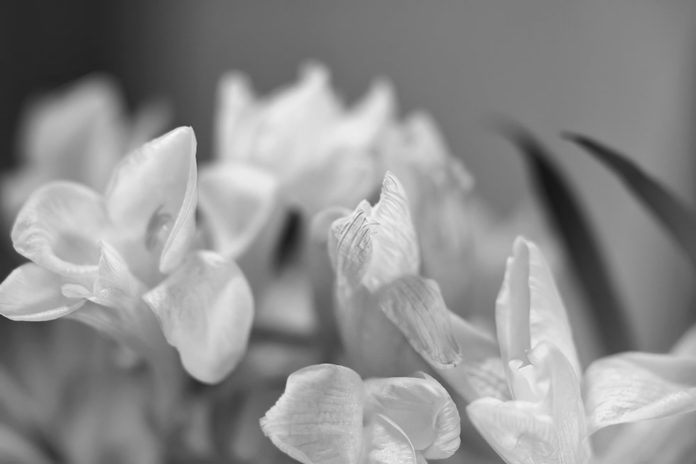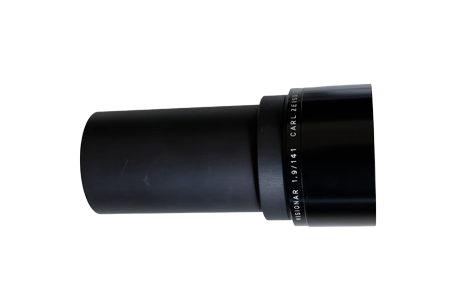The Visionar 141 mm f/1.9 is a cinema projector lens manufactured by Carl Zeiss Jena (VEB Carl Zeiss Jena, East Germany). The lens was also sold under the ROW – Rathenower Optische Werke brand. It’s a fast double‑Gauss‑type (6/6) optic with no aperture and no focusing helicoid — built for brightness and even field illumination in 35 mm film projectors. Most copies were made in the GDR/East Germany. Typical projector barrel interface is 62.5 mm (some runs use 52.5 mm), and while the design’s image circle is tied to the 35 mm 18×24 mm movie frame, many samples illuminate full‑frame (24×36 mm) sensors in practical use.
At‑a‑glance
- Type: 35 mm projector objective (no iris, no focus)
- Optics: ~6 elements / 6 groups (Visionar family)
- Mounting barrel: usually Ø 62.5 mm; some Ø 52.5 mm variants
- Coverage: designed for 18×24 mm; often usable on full frame
- Origin: Carl Zeiss Jena (DDR); also ROW-branded copies exist
Pricing (used market)
Documentation of new pricing from the projector era is scarce, but the current market is healthy: rough examples have sold around $45; typical clean copies commonly run ~$120–$300; rehoused/focus‑integrated conversions can reach $400–1,200+ depending on mount and finish. (Examples: community sale at $45 (fungus), forum users reporting $120 buys, and rehoused sales well above $1k).
Build and ergonomics
A solid, all‑metal cylinder with big glass and no controls: there’s no iris and no focus ring. Expect substantial weight (≈ 1.1 kg is typical for this focal length in the series) and a broad barrel that benefits from a tripod collar once adapted. Coatings are a single‑layer era; flare control isn’t modern.
Optical performance
- Sharpness — Good center detail at f/1.9 with a classic, slightly soft vintage glow; edges depend on subject distance due to field curvature. Like other Visionars, not a flat‑field landscape lens; it’s a shallow‑DoF portrait/character optic. (Behavior closely matches published tests of the 183/1.9 sibling).
- Color & contrast — Moderate global contrast (single‑coated era). Files respond well to gentle post‑contrast. Stray light can sap micro‑contrast.
- Projector lens bokeh & rendering — The point of this lens: big, smooth background blur with low mechanical vignetting, so cat’s‑eye highlights stay roundish deep into the frame at portrait distances. Outlining can appear at far focus.
- Flare & CA — Veiling flare is the main weakness; avoid strong light sources skimming the front element, or use a deep hood/flag. Longitudinal CA can show on high‑contrast edges.
- Distortion & vignetting — Geometric distortion is minimal; optical vignetting contributes to the look wide open and eases at closer focus.
Digital adaptation
What you need (mirrorless or DSLR):
- Clamp the barrel → 62.5 mm to M65 or 52.5 mm to M65 clamp (pick the size your copy actually has).
- Add focus → an M65 helicoid (common and inexpensive); e.g., a 25–55 mm travel range works well for portraits/close-ups.
- Mount to camera → M65→your mount ring (e.g., M65→Sony E, M65→Canon RF/EF, M65→Nikon Z, M65→L).
- (Optional) M65 extenders to fine‑tune infinity/close‑focus range.
Why this works: the Visionar has no fixed flange standard — you set the back focus with the helicoid plus spacers. Mirrorless mounts (short flange) offer the most room and the easiest infinity. DSLRs also work; you assemble the stack to achieve infinity at the helicoid’s near‑minimum extension and lock it down. A generic tele tripod collar around the barrel is recommended for balance (a trick used in published adaptations of longer Visionars).
Stopping down (optional):
There’s no built‑in iris. If you want more DoF/contrast:
- Insert an M65 inline iris module between helicoid and camera, or drop a metal disc (Waterhouse‑style) with a hole into the adapter tube. This reduces aberrations at distance but changes bokeh.
Barrel sizes to know:
- Many CZJ/ROW Visionars at this focal length use Ø 62.5 mm; some “western” projector standards use Ø 52.5 mm. Measure yours before ordering the clamp.
Coverage note: Nominal design is for the 18×24 mm movie frame; many samples cleanly illuminate the full-frame with minimal mechanical clipping — part of what makes this lens fun for bokeh panoramas.
Historical and collector context
The Visionar series spans multiple focal lengths (1.6/55; 1.6/92; 1.6/100; 1.6/109; 1.9/141; 1.9/168; 1.9/183; 1.9/200, etc.) and was built for mid-20th-century cinema projectors, e.g., Zeiss Ikon/Ernemann projectors. ROW‑branded units are optically identical to CZJ-branded units and can be more affordable. Interest in mirrorless cameras surged because their lenses are fast, easy to adapt, and deliver a distinctive rendering.
Impressions
Treat the Visionar 141/1.9 as a special‑effects tele: center your subject, put textured backgrounds behind them to “light up” the blur, and watch your angles to avoid stray light. A deep hood or flag helps a lot. If you need more bite for distant scenes, try a drop‑in stop/iris in the M65 tube. For handling, support the lens with your left hand or a collar, and let the helicoid do the fine focus.
Sample Photos

Verdict — Pros and Cons
Pros
- Very fast tele with huge, pleasing bokeh
- Simple, low‑cost adaptation using 62.5/52.5→M65 clamp + M65 helicoid
- Full‑frame‑friendly rendering for many copies; minimal mechanical cat’s‑eye towards corners
- Affordable compared to modern f/2 tele primes; ROW copies often cheaper
Cons
- No focus / no iris — you must build a focusing stack and (optionally) add a stop
- Flare‑prone; single‑coated era contrast under hard light
- Heavy barrel; needs support/collar for comfort
- Sample‑to‑sample variation: measure barrel size (62.5 vs 52.5 mm) before ordering parts




